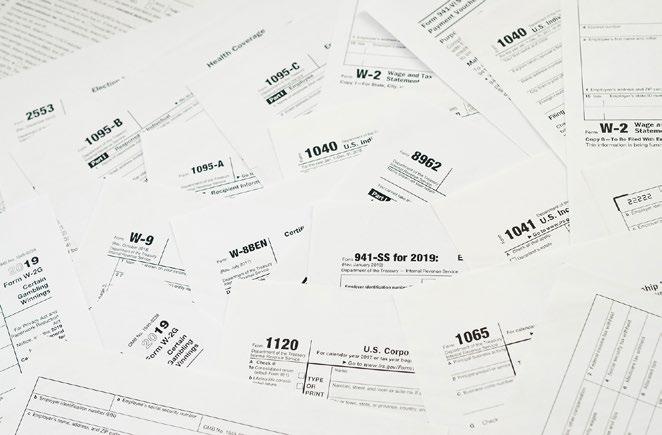
16 minute read
ARE YOUR ICS REALLY EES? A LOOK AT WHO’S WHO ON AN EMPLOYEE BENEFIT PLAN … THE SAGA CONTINUES
by SIPC
Written By Philip Qualo and Kelly E. DempseyL Last time we addressed the issue of classifying workers in the March 2020 issue of The Self-Insurer, the world was a totally different place.
Face masks were only worn by doctors during surgery, quarantine was a term almost exclusively used in sci-fi and horror movies, and the blurry rules applicable to classifying workers had remained relatively unchanged for decades.
Advertisement
What a difference a year can make! Facemasks have become the hottest new accessory, “Zoom fatigue” is a real thing, a new administration, and an entirely new framework for classifying employees and independent contractors is on the horizon.
For most laymen, the question of whether a worker is an employee or an independent contractor is simple…an independent contractor is compensated by Form-1099, and an employee is compensated by Form W-2 as well as subject to federal and state tax withholding.
What are clients saying about our EmCap® program?
- CFO, Commercial Construction Company
- Broker

- President, Group Captive Member Company
- President, Group Captive Member Company
- HR Executive, Group Captive Member Company
People are talking about Medical Stop Loss Group Captive solutions from Berkley Accident and
Health. Our innovative EmCap® program can help employers with self-funded employee health plans to enjoy greater transparency, control, and stability.
Let’s discuss how we can help your clients reach their goals.
This example is illustrative only and not indicative of actual past or future results. Stop Loss is underwritten by Berkley Life and Health Insurance Company, a member company of W. R. Berkley Corporation and rated A+ (Superior) by A.M. Best, and involves the formation of a group captive insurance program that involves other employers and requires other legal entities. Berkley and its affiliates do not provide tax, legal, or regulatory advice concerning EmCap. You should seek appropriate tax, legal, regulatory, or other counsel regarding the EmCap program, including, but not limited to, counsel in the areas of ERISA, multiple employer welfare arrangements (MEWAs), taxation, and captives. EmCap is not available to all employers or in all states.
Stop Loss | Group Captives | Managed Care | Specialty Accident
Many are surprised to find out that the analysis is far more complicated than which tax form is provided annually. For employers, this is a far more complex undertaking (whether they realize it or not). Employee status triggers employer obligations under various federal and state laws that do not apply to independent contractors, and the responsibility for classifying a worker correctly falls squarely on the employer.
The implications are even larger for employers that sponsor self-insured health plans - correctly classifying workers is an extremely important undertaking as offering coverage to independent contractors can create significant compliance issues for their health plans as well as issues with stop-loss reimbursement.
No bright-line test exists to determine when a worker should be classified as an employee rather than as an independent contractor. In September 2020, the U.S. Department of Labor (DOL) issued proposed rules aimed at simplifying classification of workers. Final rules were published on January 7, 2021 with a March 8, 2021 effective date; however, actions taken by the Biden administration delayed the effective date of the final rule to May 7, 2021.
To further complicate matters, on March 11, 2021, proposed rules to withdraw the final rules published on January 7 were issued. While it is likely these rules will be withdrawn without much objection, it is important to understand what was being proposed as it is possible future rules may arise as the concept of employee vs. independent contractor is a very hot topic, especially in California.
Prior to the DOL issuing final rules, California had previously placed California Proposition 22 on the November 2020 ballot. California Proposition 22 established more stringent classification standards for certain workers and it is likely the lobbying entities will seek similar legislation in other states. Changes to state law and the impending federal rules make this a good time for employers to start reviewing their own internal processes for classifying workers (that is if employers did not heed Ms. Dempsey’s prior article - see The Self-Insurer March 2020 edition).
Before we dive into the final rules that are now pending withdrawal, it is important to emphasize why this classification matters. Employers are required to withhold income taxes based on information employees provide on IRS Form W-4. If an employer fails to withhold income taxes on behalf of a worker improperly classified as an independent contractor, and the individual has failed to pay the taxes, the employer may be liable for federal or state taxes that were required to be withheld but were not.
Furthermore, independent contractors are not eligible to receive tax-free benefits from an employer - such as an offer of coverage to participate in a self-insured health plan. If an employer chooses to offer health care benefits to an independent contractor, the contractor must pay income taxes on the value of the benefit.
Additionally, if the company includes an independent contractor in its defined benefit pension plan, it risks losing the tax-exempt status of the plan. Employers offering self-insured health coverage to independent contractors are especially vulnerable to compliance risks for the plan, including inadvertently creating a Multiple Employer Welfare Arrangement (MEWA) plan subject to state law and no longer protected by ERISA preemption mandates.

Historically, the DOL, Internal Revenue Services (IRS), and federal courts have interpreted the Fair Labor Standards Act (FLSA) to consist of a broad general rule that a worker was an independent contractor, and not a bona fide employee, if the employer had the right to control or direct only the result of the work of an individual, as opposed to what will be done and how it will be done.
To determine how to properly classify workers and assess the degree of control and independence in the employer/worker relationship, the agencies and the courts have focused on three broad categories, which consist of a total of 20 factors for employers to consider when determining whether a worker was a bona fide employee of the employer, or an independent contractor.
The 20 factor list is fairly exhaustive and can be overwhelming, however, the categories are seemingly straightforward. The first category is behavioral control - a worker is an employee when the business has the right to direct and control the work performed by the worker, even if that right is not exercised.
The second category focuses on financial control - whether the business has a right to direct or control the financial and business aspects of the worker's job.
The third category focuses on the relationship between the parties. Essentially, an expectation that the relationship will continue indefinitely, rather than for a specific project or period, is generally seen as evidence that the intent was to create an employer-employee relationship. Ultimately, whether a worker was an independent contractor or employee depended on the facts in each situation.
Towards the end of 2020, however, the DOL published a proposed rule revising its interpretation of the FLSA's classification provisions to determine whether a worker is an employee or independent contractor.
Subsequently the rules were finalized very early in 2021 but are now subject to withdrawal. With that said, it is important to understand what these rules would have changed. Under the “economic reality test”, the DOL would consider whether a worker is in business for themselves and thus is an independent contractor, or if the worker is economically dependent on an entity for work and is an employee.
In making this determination, the DOL would identify two core factors: (1) the nature and degree of the worker's control over the work (2) the worker's opportunity for profit or loss based on initiative or investment. It also will identify three other factors

These factors include the amount of skill required for the work, the degree of permanence of the working relationship between the worker and the potential employer, and whether the work is part of an integrated unit of production.
The DOL noted that the first two core factors are entitled to greater weight than the other factors. The first factor would suggest that an individual is an independent contractor to the extent that he or she exercises substantial control over key aspects of the performance of the work.
Examples of an individual's substantial control include setting his or her own work schedule, choosing assignments, working with little or no supervision, and being able to work for others, including a potential employer's competitors.
In contrast, the control factor would weigh in favor of classification as an employee to the extent that a potential employer, rather than the worker, exercises substantial control over key aspects of the work, such as imposing requirements that the individual work for the employer exclusively during the working relationship.
The second factor would suggest that an individual is an independent contractor if he or she has an opportunity for profit or loss on either the exercise of personal initiative, including managerial skill or business acumen or the management of investments in or capital expenditure on (for example, helpers, equipment, or materials). As for the skill factor, the DOL proposed focusing on the amount of skill required. Because the worker's ability to work for others is already analyzed as part of the control factor, the final rule articulates the permanence factor without reference to the exclusivity of the relationship between the worker and potential employer.
The permanence factor would weigh in favor of an individual's being classified as an independent contractor when the working relationship is definite in duration or sporadic. By contrast, the factor would suggest someone is an employee if the working relationship is indefinite in duration or continuous.
The "integrated unit" factor would focus on whether an individual works in circumstances similar to a production line. This factor weighs in favor of employee status where a worker is a component of a potential employer's integrated production process, whether for goods or services.
The overall production process must be an integrated process that requires the coordinated function of interdependent subparts working toward a specific unified purpose. This may happen when the worker depends on the overall process to perform work duties.
According to the DOL, if the first two core factors—control and opportunity for profit or loss—point toward the same classification, their combined weight is substantially likely to outweigh the other factors.
This differs from the original test supported by the agencies as the actual practice of the parties involved will be considered more relevant than what may be contractually or theoretically possible.

Stop Loss Solutions for Level-Funded Programs

As a leading national Stop Loss company, HM Insurance Group (HM) works to deliver the right financial protection for the client at hand – whether it’s an employer of 1,000 or a group of a much smaller size.
Not only does HM write Stop Loss policies for traditional self-funded groups, the company also works with partners offering level-funded solutions to small groups interested in balancing the customization and autonomy of self-funding with the consistency and financial security associated with a fully insured plan.
Since smaller, less well-capitalized groups may have cash flow challenges or concerns about having too small of a risk pool for a traditional self-funded arrangement, level funding offers a coverage alternative. A plan is designed with a set payment structure to fund it. Stop Loss insurance is embedded, helping to mitigate the financial risk of catastrophic claims. That’s where HM comes in, helping to guard the financial health of the employers selecting level-funded benefits programs.
HM’s Level Funding Arrangements
• Partners with ASO carriers and TPAs, delivering Stop Loss protection for their small group programs • Holds 1/3 ownership of AST Risk, a leading MGU for small group level funding programs that are managed through TPAs
Product Options
• Aggregate only coverage at a 70% attachment – similar to a fully insured plan and with a possible dividend if the business runs very well (offered through AST Risk) • Aggregate only coverage at a 110% to 125% attachment – designed for groups that want to take some risk and potentially experience the savings associated with self-funding • Traditional Specific coverage and 110% Aggregate coverage (associated with level funding) • Traditional Specific and 125% Aggregate coverage
Why HM?
• Significant Stop Loss experience across a range of group sizes • More than 35 years in the Stop Loss market • National carrier with licenses in 50 states and
Washington, D.C.
• Committed to delivering the right protection
at the right price • Accessible, approachable leaders
Work with HM Insurance Group
If you’re a TPA or ASO carrier working to offer a level-funded program and are looking for a partner to deliver the Stop Loss protection, or if you’re a broker with clients seeking level-funded options, contact your HM sales representative or email HMSales@hmig.com to find out more about the opportunities available to you through HM Insurance Group and our partners.
Guarding Financial Health 800.328.5433 | hmig.com
*AM Best Company, Best’s Rating Reports, September 2020 Note: The attachment points will not be lower than any state required minimums. Coverage is underwritten by HM Life Insurance Company, Pittsburgh, PA, in all states except New York under policy form series HMP-SL (11/16), HMP-SL (08/19) or HMP-SL (06/20), AST-HMP-SL (06/20) or similar. In New York, coverage is underwritten by HM Life Insurance Company of New York, New York, NY, under policy form series HMP-SL (11/16), HMP-SL (08/19) or HMP-SL (06/20) or similar. The coverage requested may not be available in all states and is subject to individual state approval.
The proposed withdrawal of the final rules outlines various reasons the rule should not become effective. In short, based on over 1,500 comments received, the DOL now believes the final rules create more confusion and potential inconsistency in application as opposed to providing clarity and certainty as intended.
While these rules now face even greater uncertainty than just delayed application, one state has already implemented their own set of stringent rules for worker classifications that have been making headlines since the November elections.
CALIFORNIA’S PROPOSITION 22
As mentioned above, California’s Proposition 22 was on the ballot in November 2020 and passed with a relatively narrow majority at 58%. Several key requirements now apply to “gig companies” – sometimes referred to as “on-demand companies” and better known by their names including Uber, Lyft, DoorDash, and Instacart.
These on-demand companies must provide (1) an hourly wage equal to 120% of local or state minimum wage requirements for time spend on rides; (2) a stipend for health insurance for individuals working 15 hours or more per week; and (3) access to accident insurance.
The catch-22 (pun intended) is that Proposition 22 also solidifies an exemption under state law for these same on-demand ride-hail and delivery companies to treat workers as independent contractors. This means these workers are not protected by California’s generous employee protections, including paid sick leave laws.
Many following these developments in California have observed that California has essentially created a third category of workers. Aside from the general controversy surrounding the new requirements and permanent independent contractor status, the success in California means the door to additional states having similar laws has been kicked open.
NEW JERSEY CLASSIFICATION PENALTIES
Faithful readers may recall the March 2020 discussion of New Jersey’s modifications to worker classification laws. Some rules took effect in late 2019 and additional requirements began in April 2020.
As a quick refresher, one very notable change was the addition of monetary penalties for misclassification of employees and independent contractor. Penalties include an administrative penalty for misclassifying an employee beginning at $250 per misclassified employee and increasing for subsequent violations to a maximum of $1,000 per misclassified employee. The second penalty is a monetary amount that is to be no more than 5% of the worker’s gross earnings over the past 12 months. The limitation applies to the earnings from the employer that actually misclassified the individual – meaning a new employer that has contracted to work with the independent contractor cannot be held accountable for the prior employer’s mistake.
Given the radical turn 2020 took with the pandemic, it is likely to be some time before information on violations make their way to the surface.
FINAL CONSIDERATIONS FOR SELF-INSURED PLANS
Those familiar with self-funding will know that private self-insured employers are generally used to enjoying ERISA preemption of state law; however, as classification of workers is a rule directed to employers, the lines begin to blur and as discussed, these rules can have an impact on how an employer is offering a self-insured benefit plan.
Classification of workers is certainly an area of regulation that will continue to develop at a state and federal level. In addition to the various federal laws that include testing requirements (such as the Mental Health Parity Addiction Equity Act, Code Section 125, and Code Section 105(h)), employers will need to remain acutely aware of how they are classifying workers regardless of whether or not the final rules take effect. While the future always carries a fair amount of uncertainty, being proactive and assessing the status of their current workforce is something that employers should not ignore.
Philip Qualo, J.D. is Compliance and Regulatory Affairs Consultant, Philip provides consulting services to employers, third-party administrators, brokers, and vendors on an array of topics focused human resource and employee health benefit plan compliance. He proactively monitors the legal and regulatory environment to identify legal, regulatory and compliance-related gaps and advises internal and external stakeholders on areas of risks. Philip is also the founder and Chairperson of The Phia Group’s Diversity Inclusion Committee. He earned his J.D. from Villanova University School of Law. Philip’s professional experience has ranged from practicing employment law specializing in disability litigation, to managing federal grants and advocating for underserved communities. Kelly E. Dempsey is an attorney with The Phia Group, LLC. As the Vice President of Phia Group Consulting, Kelly’s specialization is an interesting mix of compliance matters impacting self-insured plans (such as issues relating to ERISA, ACA, COBRA, FMLA, MHPAEA, and MSP) and “outside-the-box thinking,” finding creative and innovative ways to help plans, brokers, and TPAs achieve their various self-insured goals. Kelly earned her Juris Doctorate from ClevelandMarshall College of Law and is admitted to the Bar of the State of Ohio and the United States District Court, Northern District of Ohio. Kelly is a board member for Project: LEARN of Medina County (Ohio) and the Chi Alpha Nu Alumnae Board.
NOBODY ELSE DOES WHAT WE DO.
Our clients are protected with MORE
FUTURE COST AND UTILIZATION INSIGHT COST SAVINGS AND COST AVOIDANCE MEMBER EDUCATION AND ADVOCACY MOST DEFENSIBLE DIALYSIS REPRICING
Recent court rulings make a Multiple of Medicare repricing for dialysis risky for plans and support Renalogic as a safe harbor.

We’re putting an end to surprise dialysis claims. Empower your plan with one call: 888.808.9380.
RENALOGIC.COM






